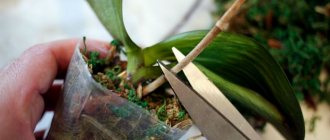Warning
: Use of undefined constant callback_thumbing_img — assumed 'callback_thumbing_img' (this will throw an Error in a future version of PHP) in
/var/www/u0885669/data/www/moiorhidei.ru/wp-content/themes/motheme/includes/ kama_thumbnail.php
on line
337
Orchids are beautiful flowers that conquered the world of floriculture back in the century before last. Their beauty during the flowering period is unique and inimitable. Unfortunately, each such phase ends. This brings sadness and at the same time hope and anticipation of a new color. In this article we will discuss caring for your orchid after flowering.
In total, orchids have 5 phases of the life cycle, and they differ from each other in the care and external characteristics of the flower. Flowering is the most beautiful and expected phase after which it is necessary to immediately change the temperature, lighting, and humidity regimes. And you can carry out a transplant.
How and how long do orchids bloom?
Different types of orchids bloom differently. For example, phalaenopsis flowers resemble butterflies in shape, and dendrobium flowers resemble miniature lilies. They also differ in the duration of flowering. When the appropriate conditions are created and proper care is taken, the flowering of phalaenopsis will be almost continuous. Dendrobium blooms seasonally, over several months. So, the orchid has faded, what to do next?
Caring for phalaenopsis after flowering
Towards the end of flowering, the phalaenopsis peduncle becomes covered with a waxy coating; usually, after this moment, new flowers no longer appear on it. After the flowers have completely fallen off, further actions largely depend on its condition.
If the flower stalk begins to dry out
After the orchid has finished blooming, you should not immediately start pruning it. You need to wait for a while and observe her condition. If during this time the peduncle turns brown and dries out, you can cut it off completely. It should be cut right to the base. Otherwise, the remaining stump will become a source of various infections and putrefactive diseases.
In some cases, the peduncle dries out only partially. In such a situation, it is best to hold off on pruning. Gradually, the dying arrow gives nutrients to the mother plant. If you cut it out too early, it will affect the overall condition of the orchid.
Another scenario for the development of events after the orchid has bloomed is when the upper part of the peduncle has dried up, and the dormant buds below begin to swell. In this case, the peduncle is carefully trimmed to living green tissue.
If the peduncle remains green
Beginning flower growers very often ask what to do after the orchid has faded, but the peduncle still remains green? In this case, there is no need to take any pruning action. Soon the plant will bloom again. But it should be borne in mind that in this case more careful care will be required. The absence of a rest period will significantly weaken the orchid, so it will need more intensive nutrition.
Basic rules of care
In most cases, after the orchid has bloomed, it begins a short period of rest. During this process, the plant needs to create the following conditions:
- daytime temperature is not higher than +25 °C, night temperature is within 16–18 °C;
- bright diffuse lighting;
- minimum humidity; spraying during this period should be completely abandoned.
But also during this period she should be given appropriate care:
- Watering is reduced to a minimum. Subject to the temperature conditions specified above, watering is carried out once every two weeks;
- Any feeding and fertilizing are completely excluded.
Subject to such conditions and care during the dormant period, the plant fully restores its strength. This usually takes no more than two months. Then watering gradually begins to increase, and the plant, when growth resumes, is transplanted into a fresh substrate.
Trimming the wilted peduncle
A typical mistake of novice florists is early removal of flower stalks on orchids. If you cut off the green part of the arrow immediately after dropping the buds, the plant may throw out a new shoot. Removing the green shoot encourages the orchid to bloom again. But a weakened plant does not have the strength to form new buds. Such a rash act by a gardener can cause illness or even death of an indoor flower.
The peduncle should be trimmed at the drying stage. When the shoot becomes light yellow and dry, you can remove it. It is recommended to use garden shears or a sharp knife to trim the peduncle. The height of the stump should not exceed 1–2 cm. If there are dormant buds on the peduncle, the intended cutting location is shifted by 1.5–2 cm.
Scheme for trimming the peduncle after flowering
The cut site is treated with beeswax. Such measures for caring for exotic indoor flowers prevent the development of fungal and bacterial infections.
Caring for dendrobium after flowering
Dendrobium is another common orchid. Its flowering period occurs in late autumn and winter. Unlike phalaenopsis, it does not produce a separate peduncle. Therefore, after the orchid has bloomed, there are no questions about what to do with the arrow. At this moment, the dendrobium begins a period of active growth. It actively grows young pseudobulbs, which will subsequently develop their own root system. So, the dendrobium orchid has faded, what to do next?
Transfer
If the dendrobium was purchased quite recently and has just finished flowering, there is no need to replant it. If your plant has been growing for a number of years without changing the substrate, then it needs replanting. It should be started after the new pseudobulbs reach a size of at least 10 cm.
This will require a special substrate consisting of bark and sphagnum moss. You can purchase it at a specialized flower shop. A pot for growing dendrobium does not have to be transparent. The main thing is that it has enough drainage holes.
The transplant process itself is as follows:
- A layer of gravel is placed at the bottom of the new pot; it not only acts as a drainage layer, but also prevents it from tipping over.
- The largest pieces of bark are placed on top of the drainage.
- The orchid's root system is carefully placed on the bark.
- The remaining space between the roots is filled with finer bark.
- The top of the substrate is covered with a layer of moss.
Pruning pseudobulbs
Dendrobimum pseudobulbs bloom only once, but at the same time you can observe a repeated wave of flowering from dormant buds. The buds of this orchid are located along the entire length of the pseudobulb. Therefore, if only the crown bloomed for the first time, then when the appropriate conditions are created, flowering will also be observed on the lower part.
After the dendrobium orchid has bloomed, you should not immediately cut off the pseudobulbs for one more reason. For her, they are a kind of storage organ. Old pseudobulbs give their nutrients to young shoots.
They begin pruning only after the leaves have completely fallen off and withered. To do this, the bulbs are carefully cut out at the very base using a sharp knife or pruning shears.
Attention! The sections obtained during the cutting process must be treated with cinnamon powder or ground charcoal.
Watering
After the orchid has bloomed, it continues an active period of growth. At this moment, it needs abundant, timely watering. This can be done either by immersion or by pouring the substrate. Water for irrigation must be warm and pre-settled. In this case, the upper part of the substrate must dry out between waterings.
Feeding
During the period after flowering, the dendrobium continues to actively develop, and at this moment it needs to be fed. To do this, it is best to use specialized fertilizers for orchids. The average frequency of feeding should be no more than once every two weeks.
So we learned how to prune a faded orchid, and what to do in cases where the plant refuses to bloom again?
Transfer
One aspect of caring for orchids after flowering is replanting. It must be done very carefully and carefully so as not to damage the flower. A transplant requires serious reasons, such as:
- Decrease in soil quality. Sometimes the substrate will form a clump around the roots, which reduces aeration and can lead to rot.
- Insufficient capacity. If the flower was last replanted more than two years ago, it may grow out of its pot. The roots are very intertwined and some of them are beginning to dry out. To avoid this, a transplant is performed.
The transplant must take place in several stages. The first step is preparing the soil. The substrate components must be well crushed and disinfected. Here are some simple examples of what good soil looks like:
- pine bark - 5 parts;
- moss – 1 part;
- charcoal - 1 part;
- expanded clay and pumice - drainage.
Medium substrate:
- charcoal - 1 part;
- moss – 2 parts;
- pine bark and wood chips - 5 parts.
Important. It is best for inexperienced flower growers to buy ready-made soil in a specialized store.
The second stage is preparing the tools. You need sterilized scissors, gloves and crushed charcoal.
The orchid is carefully removed from the pot and the roots are cleaned of the remnants of the old substrate. If there are dried or rotten roots, then sanitization is carried out. Unnecessary parts of the root are carefully cut off, and the sections are rubbed with charcoal.
Important! It is necessary to carefully examine the entire root system so as not to leave a single diseased area.
The cleaned orchid is left to dry for 30 minutes. After this, they are strengthened on new soil. This must be done carefully, trying not to damage the roots. First, a third of the substrate is poured into the bottom of the pot, and then the roots are added. The rest is poured on top. There is no need to compact the soil. It is best to gently shake the pot several times.
How to make an orchid bloom again
In most cases, phalaenopsis and dendrobim bloom easily at home. But sometimes there may be no flowering for a whole series. The most likely and common of them are discussed below.
Lack of lighting and non-compliance with temperature conditions
All orchids come from the tropics, so they need bright lighting for normal development. With a lack of light, their growth processes slow down and the plants begin to experience stress. Its result can be either a lack of flowering or complete death.
With a lack of natural light. Especially in the autumn-winter period, it is recommended that orchids be equipped with lighting. To do this, you can purchase special photo lamps or use regular fluorescent lamps. The total length of daylight for orchids, even during the dormant period, should not be less than 12 hours.
Too high a temperature, especially during the dormant period, can also cause a lack of flowering. To avoid this, plants should be placed away from heating radiators, and in the summer they should be shaded from direct sunlight.
Lack or excess of nutrition
Another fairly common reason for the lack of flowering is nutritional errors. It should be borne in mind that excessive application of fertilizers is no less harmful than their lack. Orchids should be fed only during periods of intensive growth. Fertilizers should be diluted and used only in full accordance with the attached instructions. Fertilizing during the dormant period is strictly prohibited.
Air humidity
Orchids love high humidity. In winter, after turning on the heating, the air in the room becomes dry. Dry air promotes the appearance of spider mites. Our task is to create ideal air humidity around the whims in winter. To do this, you can use a humidifier, which will create favorable conditions for both us and the plants.
There are simpler options:
- Place a saucer of water near the pot
- Spray the air around the plant 2 times a day
It is not recommended to spray the leaves and flowers of orchids. Drops of moisture will accumulate near the growth point, and there is the orchid’s weak point. Excess moisture quickly provokes rotting at the base. If the process is started, you will have to say goodbye to the orchid.
Photo: Spray the air around the plant 2 times a day.
| Important. Be very attentive to this place on the orchid, especially in winter after watering and a warm shower. Always shake off moisture from the growing point and dry with extreme care. |
- You can buy transparent deep trays, pour a layer of expanded clay into them, fill them with water, lay a grate on top and place a pot with a plant on the grate. If your orchids do not have enough air humidity, the leaves begin to turn yellow and wither. The roots stop growing altogether.
- Get an indoor fountain
How to stimulate flowering?
You can stimulate re-blooming of orchids by creating stressful conditions. You can do this in the following ways:
- Severely limit watering. Sometimes, after complete drying, the plant begins to actively develop flower stalks. But moderation should be observed. Drying too much can lead to irreversible damage to the root system.
- Create a difference between day and night temperatures. In some cases, significantly lower night temperatures stimulate flowering. To do this, you can simply open the window over the plant at night.











